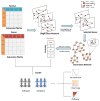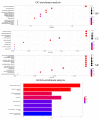HSSG: Identification of Cancer Subtypes Based on Heterogeneity Score of A Single Gene
- PMID: 35954300
- PMCID: PMC9368717
- DOI: 10.3390/cells11152456
HSSG: Identification of Cancer Subtypes Based on Heterogeneity Score of A Single Gene
Abstract
Cancer is a highly heterogeneous disease, which leads to the fact that even the same cancer can be further classified into different subtypes according to its pathology. With the multi-omics data widely used in cancer subtypes identification, effective feature selection is essential for accurately identifying cancer subtypes. However, the feature selection in the existing cancer subtypes identification methods has the problem that the most helpful features cannot be selected from a biomolecular perspective, and the relationship between the selected features cannot be reflected. To solve this problem, we propose a method for feature selection to identify cancer subtypes based on the heterogeneity score of a single gene: HSSG. In the proposed method, the sample-similarity network of a single gene is constructed, and pseudo-F statistics calculates the heterogeneity score for cancer subtypes identification of each gene. Finally, we construct gene-gene networks using genes with higher heterogeneity scores and mine essential genes from the networks. From the seven TCGA data sets for three experiments, including cancer subtypes identification in single-omics data, the performance in feature selection of multi-omics data, and the effectiveness and stability of the selected features, HSSG achieves good performance in all. This indicates that HSSG can effectively select features for subtypes identification.
Keywords: cancer subtypes; heterogeneity; pseudo-F statistic; single gene.
Conflict of interest statement
The authors declare no conflict of interest.
Figures













Similar articles
-
Novel cancer subtyping method based on patient-specific gene regulatory network.Sci Rep. 2021 Dec 8;11(1):23653. doi: 10.1038/s41598-021-02394-w. Sci Rep. 2021. PMID: 34880275 Free PMC article.
-
HCNM: Heterogeneous Correlation Network Model for Multi-level Integrative Study of Multi-omics Data for Cancer Subtype Prediction.Annu Int Conf IEEE Eng Med Biol Soc. 2021 Nov;2021:1880-1886. doi: 10.1109/EMBC46164.2021.9630781. Annu Int Conf IEEE Eng Med Biol Soc. 2021. PMID: 34891654
-
MultiGATAE: A Novel Cancer Subtype Identification Method Based on Multi-Omics and Attention Mechanism.Front Genet. 2022 Mar 21;13:855629. doi: 10.3389/fgene.2022.855629. eCollection 2022. Front Genet. 2022. PMID: 35391797 Free PMC article.
-
Identifying Cancer Subtypes from miRNA-TF-mRNA Regulatory Networks and Expression Data.PLoS One. 2016 Apr 1;11(4):e0152792. doi: 10.1371/journal.pone.0152792. eCollection 2016. PLoS One. 2016. PMID: 27035433 Free PMC article.
-
Constructing cancer patient-specific and group-specific gene networks with multi-omics data.BMC Med Genomics. 2020 Aug 27;13(Suppl 6):81. doi: 10.1186/s12920-020-00736-7. BMC Med Genomics. 2020. PMID: 32854705 Free PMC article.
References
Publication types
MeSH terms
LinkOut - more resources
Full Text Sources
Medical

